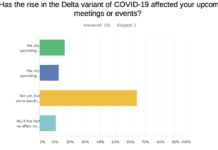Experts share their predictions about the future of meetings post-COVID-19.
We’re all starting to ask the same questions: In the immediate post-COVID-19 era, what is the future of meetings? What will they look like, feel like, once we start them up again? What precautions will be standard? How, exactly, can we make this work?
With the CDC guidelines most likely still in place when meetings start to open back up again, planners will be required to seat people 6 feet apart. As a result, hotels will need to offer additional meeting space or group sizes will need to be adjusted. With so many meetings that had been planned for spring being postponed until fall, there is sure to be confusion.
A smaller meeting than originally planned will also dictate changes in room block size and trickle down to already established F&B minimums. There will be new F&B protocols, sanitizing requirements and procedures that will need to be in place in the event that someone falls ill. And then there’s also the possibility of another wave of the virus and how that might suddenly affect attendance.
Industry associations are just beginning to convene task forces to bring planners and hoteliers together to try to sort this all out. One thing is certain: There will never be a greater test of the hotel-planner partnership than what we will see when meetings start up again.
Here are some predictions for meetings in the immediate post-COVID-19, pre-vaccine era:
Small and Local
“Small, local meetings will be the way event industry will start to build its comeback. The characteristics of these meetings could be imagined as follows:
• Small in size. Even during the scariest phase of the outbreak, different countries implemented different bans to meeting sizes: 1,000, 500, 250, 50, 10. Difficult to say.
• No travel involved. Attendees coming from the same geographic area will be perceived as safe.” Source: EventMB
On-Site Testing
“Thankfully instant testing could be here very soon. Abbott Labs announced that starting April 1st they will begin deploying a 5-minute coronavirus test delivered via a portable seven pound device that looks about the size of a trade show badge printer. Until we get a vaccine, this is our best hope.
Picture arriving at a conference and, similar to first having to pass through a metal detector, you’re now first routed to a roped off testing area administered by trained medical professionals. Those who test negative will be given a special ID bracelet designating them as cleared to enter the venue. Yes, it adds a delay and inconvenience, but one that every attendee will gladly endure. Once inside, people will be able to relax and enjoy the event without any social distancing. It may sound like a scene out of a dystopian sci-fi movie, but this may very well be our reality in the short-intermediate term.” Source: Howard Givner, Founder, Event Leadership Institute
Future of Meetings: Virtual or Not?
“This pandemic has given us the chance to mix it up and completely rethink the way we have been doing events. We have the opportunity to reevaluate our approach.
We’ve seen that many events are going virtual—and that is a start. It speaks to a new generation of attendees, platforms and possibilities. But that’s not enough either—because nothing beats face-to-face engagement for learning and connection.
As more events are cancelled or postponed, clients are rushing to find a virtual or live-stream option. But, just because you can do virtual, doesn’t mean you should. Not every event will translate over to a digital one.” Source: Niki McKay, owner of Blue Danube Productions, in Special Events
You Might Also Be Interested In
Our Latest Articles on COVID-19











